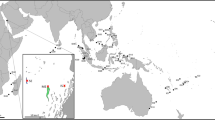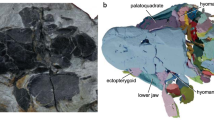This catch is evidence of transequatorial migration by a cold-water Antarctic fish.
Abstract
A large (1.80 metres in length and weighing 70 kg) Patagonian toothfish (Dissostichtus eleginoides Smitt, 1898) has been caught in the northwest Atlantic, representing the first Northern Hemisphere record of the diverse, abundant and mainly Antarctic suborder Notothenioidei. This extraordinary catch indicates that large, cold-temperate fishes may occasionally migrate from sub-Antarctic to sub-Arctic waters by using deep, cold water, supporting a widely accepted but unproven proposal that the anti-tropical distribution patterns of many marine biota could be explained by transequatorial migration1,2,3.
Similar content being viewed by others
Main
During commercial gill-net fishing for Greenland halibut in the Davis Strait (63° 02′ N, 53° 32′ W, at a depth of 1,331 m), a large, unknown fish was caught on 23 November 2000. Olaf Sólsker, the captain of the vessel Isak L, decided to freeze this strange specimen. We examined the fish and identified it as a male Patagonian toothfish, which is well known for being controversially caught by trawl and long-line fisheries in sub-Antarctic waters4.
None of the 139 notothenioid species has previously been recorded in the Northern Hemisphere5, but morphological analysis of the specimen (for example, IX and 28 rays in the dorsal fins, 28 in the anal fin and 26 in the pectoral fins) is consistent with data6 for D. eleginoides, except in a few details: the mid-lateral line does not extend forwards to the tip of the pectoral fin (Fig. 1), although the number of middle lateral-line scales (74) is within the range for D. eleginoides (64–77) and outside the range (35–48) for its sister species D. mawsoni Norman, 1937; there are two scaleless areas on the head as opposed to 12; the lower jaw has a short inner row of small teeth and a long outer row of large teeth, rather than a single row; in the upper jaw there are four rows and not two; the pectoral fin is shorter (12% of standard length, rather than 17–26%); and the body is deeper (23% of standard length, rather than 16–21%). These minor differences can be explained by allometric growth and are not indicative of a separate population or species. The only stomach content was an unidentifiable cephalopod upper beak.
It is unlikely that an unknown population of toothfish exists off Greenland, as none has been recorded during intensive fishing and surveying activity over the past 15–20 years. The species is already known to migrate over long distances (up to 1,800 km has been recorded by tracking7), and we consider it more likely that this was a stray specimen from a south Atlantic population. The furthest north that a Patagonian toothfish has been recovered before8 is in the Atlantic Ocean off Uruguay at about 32° S, indicating that that specimen must have migrated at least 10,000 km.
The temperature range of D. eleginoides is 2–11 °C (ref. 9), so the transequatorial migration of the Greenland specimen must have included submergence beneath the intervening warm tropical waters, where temperatures are less than 10 °C at depths of 500–1,500 m (ref. 6); this strategy would enable the fish to travel all the way from Patagonia to west Greenland10.
Identified species of Greenland fish fauna have increased from 116 to more than 250 in 20 years, mainly as a result of increased fishing in deep waters. However, the discovery there of a Patagonian toothfish is so far unique. This finding supports the theory that transequatorial migration can occur by isothermal submergence1,2,3, which has been proposed to explain the origin of marine anti-tropical distribution patterns.
References
Ekman, S. Zoogeography of the Sea (Sidgwick & Jackson, London, 1953).
Andriashev, A. P. Polar Biol. 11, 213–218 (1990).
Hilbish, T. J. et al. Mar. Biol. 136, 69–77 (2000).
Wienecke, B. & Robertson, G. Fisheries Res. 54, 253–265 (2002).
Balushkin, A. V. J. Ichthyol. 40 (suppl. 1), 74–109 (2000).
DeWitt, H. H., Heemstra, P. C. & Gon, O. in Fishes of the Southern Ocean (eds Gon, O. & Heemstra, P. C.) 279–331 (J. L. B. Smith Inst. Ichthyol., Grahamstown, S. Africa, 1990).
Williams, R., Tuck, G. N., Constable, A. & Lamb, T. J. Sci. Committee Commission Conserv. Antarctic Mar. Living Res. 9, 33–48 (2002).
Agnew, D. in IUCN/SSC Wildlife Trade Programme (Cambridge, UK, 2002).
Eastman, J. T. in Fishes of the Southern Ocean (eds Gon, O. & Heemstra, P. C.) 34–51 (J. L. B. Smith Inst. Ichthyol., Grahamstown, S. Africa, 1990).
Dietrich, G. & Ulrich, J. Atlas zur Oceanographie (Bibliographisches Inst., Mannheim, 1968).
Author information
Authors and Affiliations
Corresponding author
Ethics declarations
Competing interests
The authors declare no competing financial interests.
Rights and permissions
About this article
Cite this article
Møller, P., Nielsen, J. & Fossen, I. Patagonian toothfish found off Greenland. Nature 421, 599 (2003). https://doi.org/10.1038/421599a
Issue Date:
DOI: https://doi.org/10.1038/421599a
This article is cited by
-
Biodiversity of arctic marine fishes: taxonomy and zoogeography
Marine Biodiversity (2011)
-
Genetic structure of Patagonian toothfish (Dissostichus eleginoides) populations on the Patagonian Shelf and Atlantic and western Indian Ocean Sectors of the Southern Ocean
Marine Biology (2006)
-
A fish out of water
Nature (2003)
Comments
By submitting a comment you agree to abide by our Terms and Community Guidelines. If you find something abusive or that does not comply with our terms or guidelines please flag it as inappropriate.




